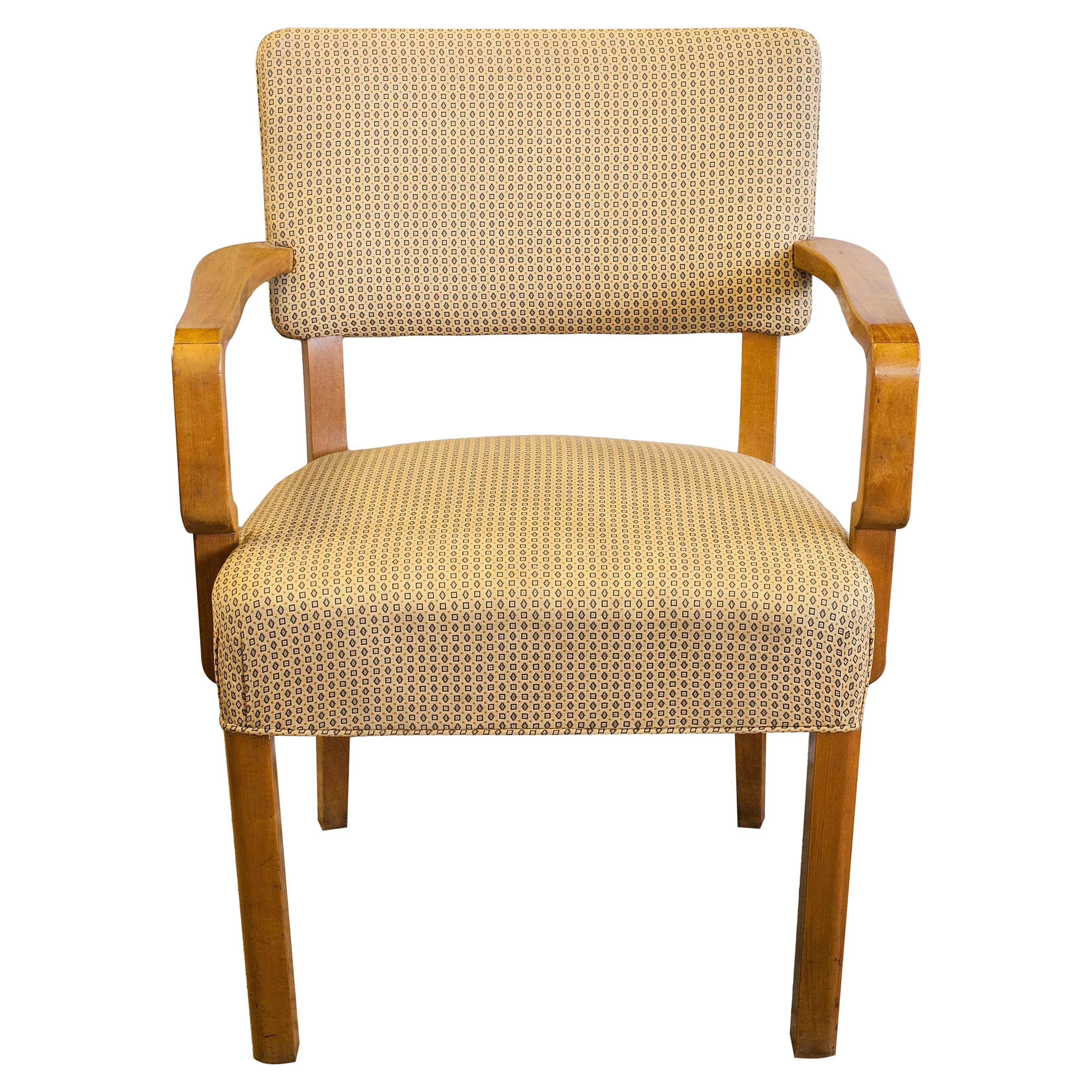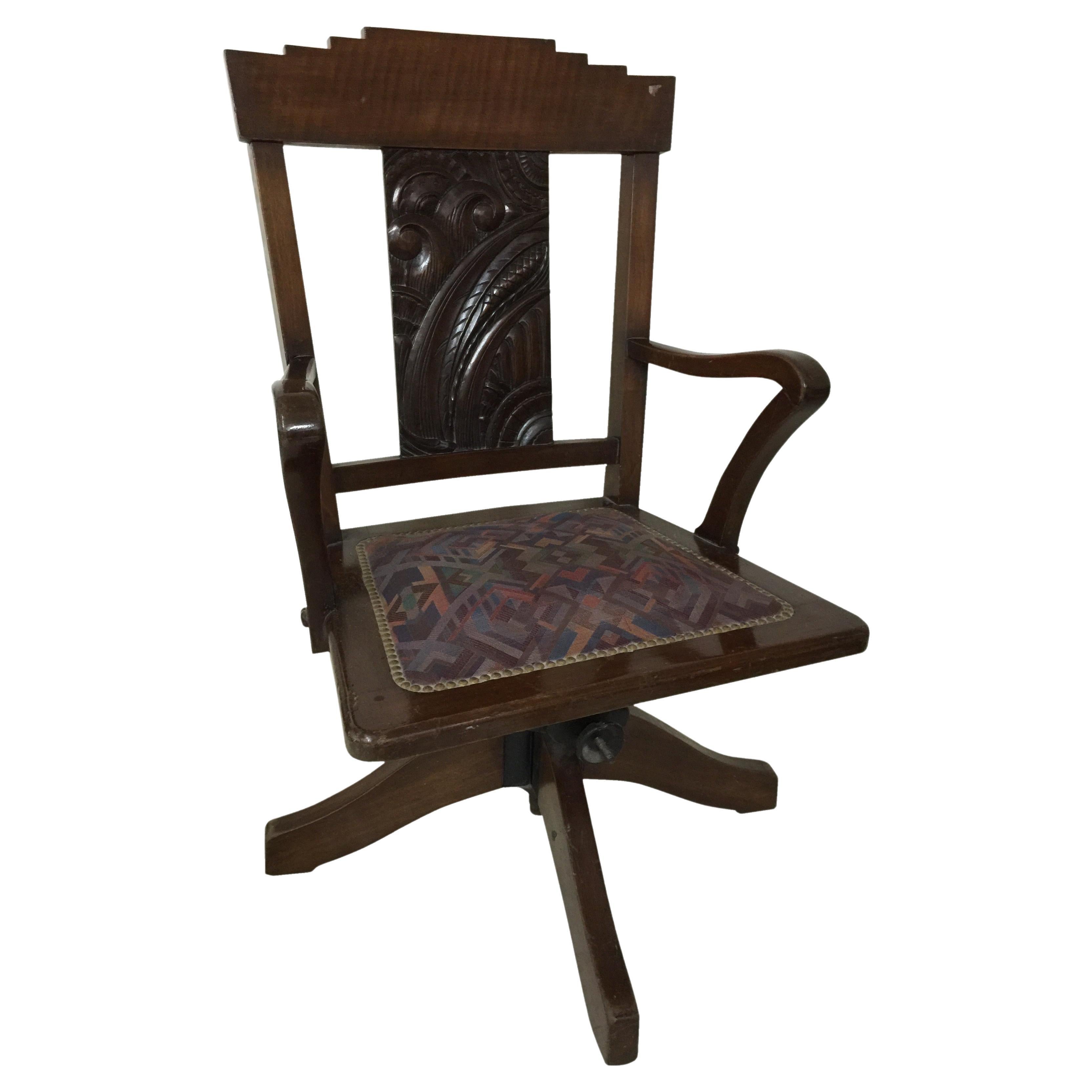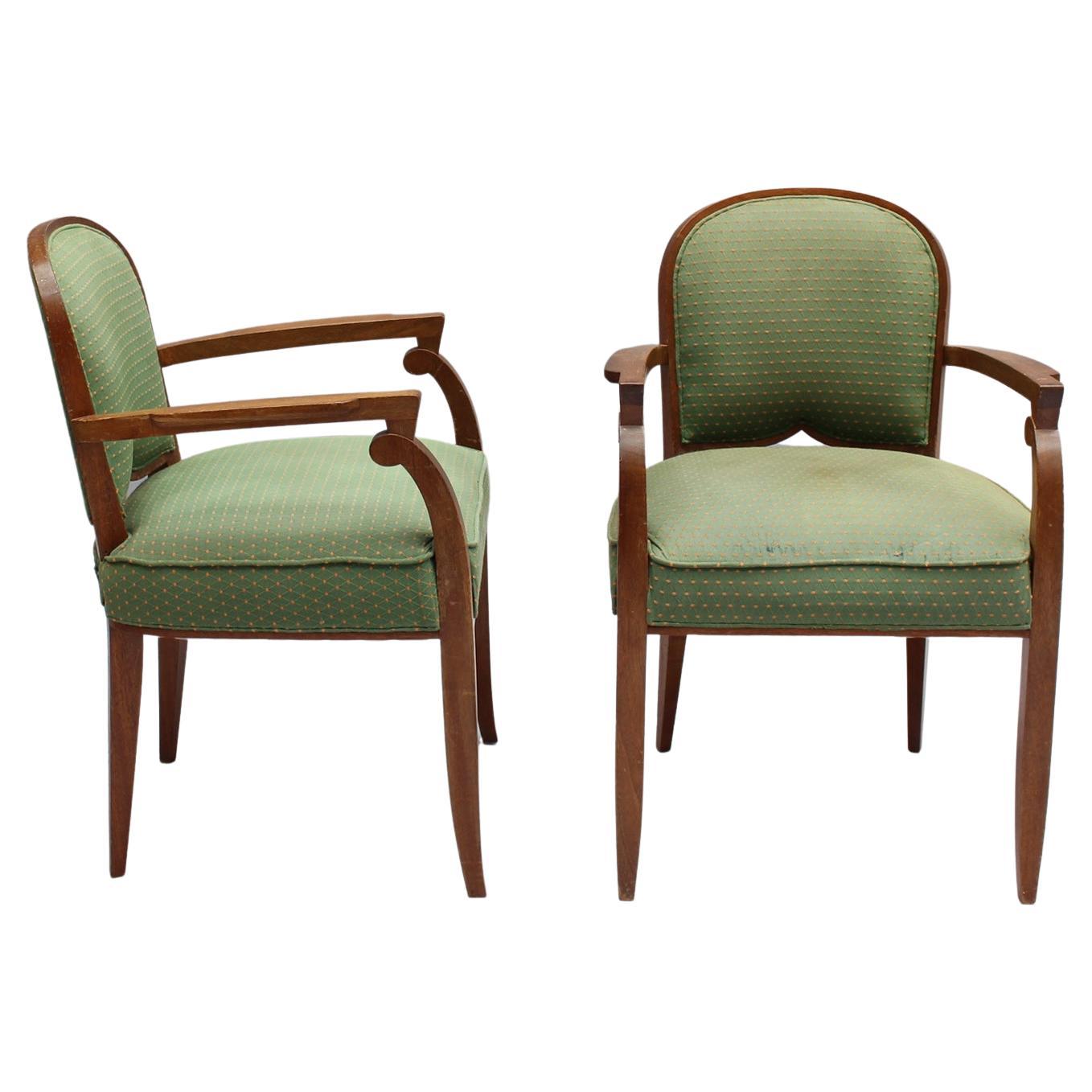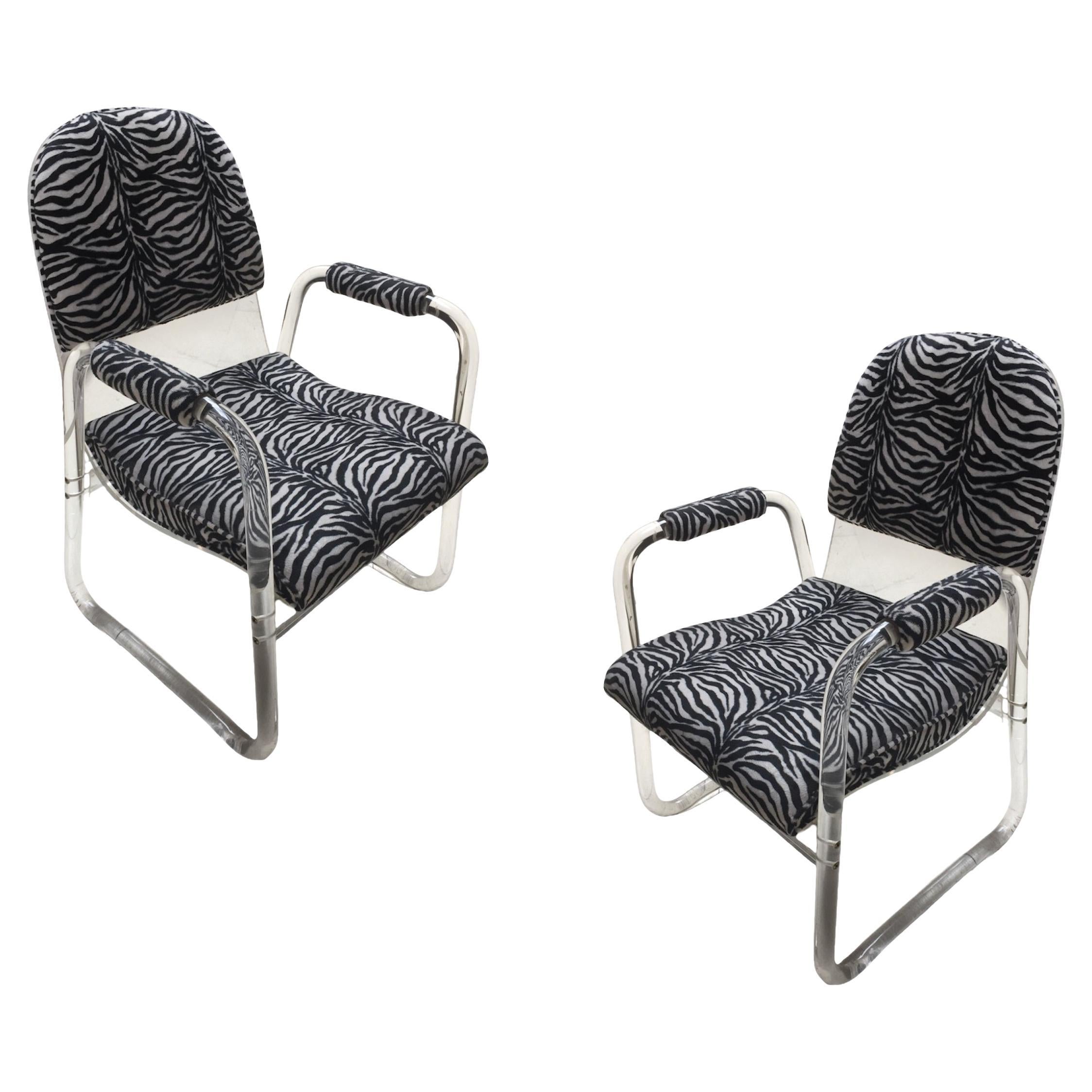Items Similar to French 1940s Neoclassical Style Desk Chair
Want more images or videos?
Request additional images or videos from the seller
1 of 11
French 1940s Neoclassical Style Desk Chair
About the Item
Chic Art Deco 1940s desk chair in blond walnut with original dark green upholstery.
- Similar to:André Arbus (Designer)
- Dimensions:Height: 39.77 in (101 cm)Width: 27.56 in (70 cm)Depth: 27.56 in (70 cm)Seat Height: 17.33 in (44 cm)
- Style:Art Deco (Of the Period)
- Place of Origin:
- Period:
- Date of Manufacture:Circa 1940s
- Condition:Wear consistent with age and use. Small distended area of leather in the seat back, visible in the photos.
- Seller Location:Isle Sur La Sorgue, FR
- Reference Number:1stDibs: LU93773227122
About the Seller
4.7
Vetted Seller
These experienced sellers undergo a comprehensive evaluation by our team of in-house experts.
Established in 1991
1stDibs seller since 2012
339 sales on 1stDibs
Typical response time: 12 hours
- ShippingRetrieving quote...Ships From: Isle Sur La Sorgue, France
- Return PolicyA return for this item may be initiated within 3 days of delivery.
More From This SellerView All
- French Art Deco Desk and Chair SetLocated in Isle Sur La Sorgue, VaucluseElegant Art Deco desk and chair set, in ebonized wood, carved with bold foliate motifs. The desk has three front drawers and two sets of shelves on ...Category
Early 20th Century French Art Deco Desks and Writing Tables
MaterialsWood
- French 19th Century Desk ChairLocated in Isle Sur La Sorgue, VaucluseHandsome 19th century desk chair raised on turned front legs, on original brass casters and saber back legs. Upholstered in original antique faux-le...Category
Antique 19th Century French Louis Philippe Office Chairs and Desk Chairs
MaterialsWood
- Louis XVI Style Swag Back Tufted Armchairs, France, 1940sLocated in Isle Sur La Sorgue, VaucluseFun, elegant and glamorous pair of round-backed armchairs with elaborately carved drapery motif backs. Outwardly scrolling rounded armrests. Carved front legs. Painted in original of...Category
Vintage 1940s French Armchairs
- Four Directoire Style Armchairs with Tapestry, France, circa 1940sLocated in Isle Sur La Sorgue, VaucluseThis set of armchairs is typical of the French pared-down and chic take on the Directoire style in the 1940s. They have a light-colored wood structure and feature wide and comfor...Category
Vintage 1940s French Armchairs
- Hepplewhite Armchair, England, Circa 1790Located in Isle Sur La Sorgue, VaucluseWide armchair in the Hepplewhite style. Shield back decorated with beading and rosettes. Graceful movement: nice, outwardly curving arms, and serpentine seat. Straight, tape...Category
Antique 18th Century and Earlier British Hepplewhite Armchairs
- Art Deco Upholstered Iron Armchair with Crown Detail, France, 1940sLocated in Isle Sur La Sorgue, VaucluseSuperb Art Deco iron armchair, newly re-upholstered in vintage, exotic chintz fabric. The structure has its original off-white paint with silver primer visible beneath. Curule base, ...Category
Vintage 1940s French Art Deco Armchairs
You May Also Like
- Desk Chair Style: Art Deco, France, 1920Located in Ciudad Autónoma Buenos Aires, CArt Deco desk chair Country: France If you are looking for a desk chair to match your desk, we have what you need. We have specialized in the sale of Art Deco and Art Nouveau and Vintage styles since 1982. If you have any questions we are at your disposal. Pushing the button that reads 'View All From Seller'. And you can see more objects to the style for sale. Why are there so many antiques in Argentina? In the 1880 – 1940 there was a grate wave of immigration encouraged by the periods of war that were taking place. 1st World War took place between 1914 and 1918 2nd World War took place between 1939 and 1945 The immigrants options were New York or Buenos Aires. Tickets were cheap and in Buenos Aires they were welcomed with open arms, as it was a country where everything was still to be done. Argentina was the country of new opportunities, labour was needed and religious freedom was assured, in many cases the of the family travel first until they were settled and then the rest of the family members join them. In the immigrant museum “Ellis Island Immigrant Building” in New York you can se the promotional posters of the boats that would take them to a new life. Between the years 1895 and 1896, Argentina had the highest DGP (gross domestic product) per capita in the world according to the Maddison Historical Statistics index, this situation arose due to the large amount of food being exported to European countries, which were at war. The Argentinean ships left the port of Buenos Aires with food, but they returned with furniture, clothes and construction elements, (it´s common to see this the old buildings of the historic neighbourhood of San Telmo, the beams with the inscription “Made in England)”, as well as many markets that were built in Buenos Aires, such us the San Telmo Market, whose structure was brought by ship and afterwards assembled in 900 Defensa Street. With the great influence of European immigrants living in the country, the children of the upper classes travelled to study in France, resulting in the inauguration of “La Maison Argentinienne”, on 27th of June 1928, in the international city of Paris, which hosted many Argentinians that were studying in Frace. It´s the fourth house to be built after France, Canada and Belgium, being the first Spanish-speaking one. Still in place today (17 Bd Jourdan, 75014, Paris, France). Many of the children of these wealthy families who attended international art exhibitions, museums and art courses abroad, took a keen interest in the European style. This is why Buenos Aires was at the time referred as “The Paris of South America”. Between the years 1890 and 1920 more than a hundred Palaces were built on Alvear Avenue the most exclusive avenue in Buenos Aires. Today some of these palaces have been transformed into museums, hotels and embassies. In the year 1936, the Kavanagh building was inaugurated, it was the tallest reinforced concrete building in South America. During 1994 the American Society of Civil Engineers distinguished it as an “international engineering milestone”, and it´s now considered a World Heritage of Modern Architecture. At the time was common to hire foreign architects such as Le Corbusier, who visited Buenos Aires/Argentina in 1929 and in 1948 he drew up the blueprints for a house built in La Plata City (which was declared a World Heritage Site). In 1947, the Hungarian architect Marcelo Breuer designed “Parador Ariston” in the seaside city of Mar del Plata. After an Argentinean student at Harvard University convinced him to come to Argentina. He worked on an urban development project in the Casa Amarilla, area of La Boca. The Ukrainian architect, Vladimiro Acosta, arrives in Argentina in 1928 and worked as an architect until que moved to Brazil. Antonio Bonet, a Spanish architect who worked with Le Corbusier in Paris, arrives in Argentina in 1937, where he carried out several architectural works and in 1938 designs the well-known BFK...Category
Vintage 1920s French Art Deco Office Chairs and Desk Chairs
MaterialsWood
- Desk Chair Style: Art Deco, France, 1930Located in Ciudad Autónoma Buenos Aires, CArt Deco desk chair Wood Year: 1930 Country: France If you are looking for a desk chair to match your desk, we have what you need. We have specialized in the sale of Art Deco and Art Nouveau and Vintage styles since 1982. Pushing the button that reads 'View All From Seller'. And you can see more objects to the style for sale. Why are there so many antiques in Argentina? In the 1880 – 1940 there was a grate wave of immigration encouraged by the periods of war that were taking place. 1st World War took place between 1914 and 1918 2nd World War took place between 1939 and 1945 The immigrants options were New York or Buenos Aires. Tickets were cheap and in Buenos Aires they were welcomed with open arms, as it was a country where everything was still to be done. Argentina was the country of new opportunities, labour was needed and religious freedom was assured, in many cases the of the family travel first until they were settled and then the rest of the family members join them. In the immigrant museum “Ellis Island Immigrant Building” in New York you can se the promotional posters of the boats that would take them to a new life. Between the years 1895 and 1896, Argentina had the highest DGP (gross domestic product) per capita in the world according to the Maddison Historical Statistics index, this situation arose due to the large amount of food being exported to European countries, which were at war. The Argentinean ships left the port of Buenos Aires with food, but they returned with furniture, clothes and construction elements, (it´s common to see this the old buildings of the historic neighbourhood of San Telmo, the beams with the inscription “Made in England)”, as well as many markets that were built in Buenos Aires, such us the San Telmo Market, whose structure was brought by ship and afterwards assembled in 900 Defensa Street. With the great influence of European immigrants living in the country, the children of the upper classes travelled to study in France, resulting in the inauguration of “La Maison Argentinienne”, on 27th of June 1928, in the international city of Paris, which hosted many Argentinians that were studying in Frace. It´s the fourth house to be built after France, Canada and Belgium, being the first Spanish-speaking one. Still in place today (17 Bd Jourdan, 75014, Paris, France). Many of the children of these wealthy families who attended international art exhibitions, museums and art courses abroad, took a keen interest in the European style. This is why Buenos Aires was at the time referred as “The Paris of South America”. Between the years 1890 and 1920 more than a hundred Palaces were built on Alvear Avenue the most exclusive avenue in Buenos Aires. Today some of these palaces have been transformed into museums, hotels and embassies. In the year 1936, the Kavanagh building was inaugurated, it was the tallest reinforced concrete building in South America. During 1994 the American Society of Civil Engineers distinguished it as an “international engineering milestone”, and it´s now considered a World Heritage of Modern Architecture. At the time was common to hire foreign architects such as Le Corbusier, who visited Buenos Aires/Argentina in 1929 and in 1948 he drew up the blueprints for a house built in La Plata City (which was declared a World Heritage Site). In 1947, the Hungarian architect Marcelo Breuer designed “Parador Ariston” in the seaside city of Mar del Plata. After an Argentinean student at Harvard University convinced him to come to Argentina. He worked on an urban development project in the Casa Amarilla, area of La Boca. The Ukrainian architect, Vladimiro Acosta, arrives in Argentina in 1928 and worked as an architect until que moved to Brazil. Antonio Bonet, a Spanish architect who worked with Le Corbusier in Paris, arrives in Argentina in 1937, where he carried out several architectural works and in 1938 designs the well-known BFK chair...Category
Vintage 1930s French Art Deco Office Chairs and Desk Chairs
MaterialsWood
- 2 Fine French 1940s Mahogany Armchairs by Jules LeleuBy Jules LeleuLocated in Long Island City, NYJules Leleu (1883-1961) - Two fine French Art Deco mahogany arm chairs by Jules Leleu. Price is per armchair, only two are available.Category
Vintage 1940s French Art Deco Armchairs
MaterialsFabric, Mahogany
- Fine French 1930s Desk ChairLocated in Long Island City, NYA fine French Art Deco stained beech armchair.Category
Vintage 1930s French Art Deco Armchairs
MaterialsWood
- Pair of Solid Lucite Vanity Chair, 1940sLocated in Ciudad Autónoma Buenos Aires, CPair of solid lucite chairs We have specialized in the sale of Art Deco and Art Nouveau and Vintage styles since 1982. If you have any questions we are at your disposal. Pushing the button that reads 'View All From Seller'. And you can see more objects to the style for sale. Why are there so many antiques in Argentina? In the 1880 – 1940 there was a grate wave of immigration encouraged by the periods of war that were taking place. 1st World War took place between 1914 and 1918 2nd World War took place between 1939 and 1945 The immigrants options were New York or Buenos Aires. Tickets were cheap and in Buenos Aires they were welcomed with open arms, as it was a country where everything was still to be done. Argentina was the country of new opportunities, labour was needed and religious freedom was assured, in many cases the of the family travel first until they were settled and then the rest of the family members join them. In the immigrant museum “Ellis Island Immigrant Building” in New York you can se the promotional posters of the boats that would take them to a new life. Between the years 1895 and 1896, Argentina had the highest DGP (gross domestic product) per capita in the world according to the Maddison Historical Statistics index, this situation arose due to the large amount of food being exported to European countries, which were at war. The Argentinean ships left the port of Buenos Aires with food, but they returned with furniture, clothes and construction elements, (it´s common to see this the old buildings of the historic neighbourhood of San Telmo, the beams with the inscription “Made in England)”, as well as many markets that were built in Buenos Aires, such us the San Telmo Market, whose structure was brought by ship and afterwards assembled in 900 Defensa Street. With the great influence of European immigrants living in the country, the children of the upper classes travelled to study in France, resulting in the inauguration of “La Maison Argentinienne”, on 27th of June 1928, in the international city of Paris, which hosted many Argentinians that were studying in Frace. It´s the fourth house to be built after France, Canada and Belgium, being the first Spanish-speaking one. Still in place today (17 Bd Jourdan, 75014, Paris, France). Many of the children of these wealthy families who attended international art exhibitions, museums and art courses abroad, took a keen interest in the European style. This is why Buenos Aires was at the time referred as “The Paris of South America”. Between the years 1890 and 1920 more than a hundred Palaces were built on Alvear Avenue the most exclusive avenue in Buenos Aires. Today some of these palaces have been transformed into museums, hotels and embassies. In the year 1936, the Kavanagh building was inaugurated, it was the tallest reinforced concrete building in South America. During 1994 the American Society of Civil Engineers distinguished it as an “international engineering milestone”, and it´s now considered a World Heritage of Modern Architecture. At the time was common to hire foreign architects such as Le Corbusier, who visited Buenos Aires/Argentina in 1929 and in 1948 he drew up the blueprints for a house built in La Plata City (which was declared a World Heritage Site). In 1947, the Hungarian architect Marcelo Breuer designed “Parador Ariston” in the seaside city of Mar del Plata. After an Argentinean student at Harvard University convinced him to come to Argentina. He worked on an urban development project in the Casa Amarilla, area of La Boca. The Ukrainian architect, Vladimiro Acosta, arrives in Argentina in 1928 and worked as an architect until que moved to Brazil. Antonio Bonet, a Spanish architect who worked with Le Corbusier in Paris, arrives in Argentina in 1937, where he carried out several architectural works and in 1938 designs the well-known BFK chair...Category
Vintage 1940s American Space Age Office Chairs and Desk Chairs
MaterialsLucite
- Desk Chair Style: Art Deco, France, Material Wood and Leather, 1930Located in Ciudad Autónoma Buenos Aires, CArt Deco desk chair Material: leather and wood Year: 1930 Country: France If you are looking for a desk chair to match your desk, we have what you nee...Category
Vintage 1930s French Art Deco Office Chairs and Desk Chairs
MaterialsLeather, Wood
Recently Viewed
View AllMore Ways To Browse
Vintage Style Desk Desks
Vintage Style Study Desk
Retro Style Desks
French Style Desk
Retro Style Office Desk
Green Office Desk
French Desk Midcentury
Retro Mid Century Style Desk
Retro Style Office Chair
Midcentury Style Office Chair
Mid Century Walnut Office Desk
1940s Vintage Desk
French Deco Desk
French Deco Desks
French Art Deco Office Desk
20th Century French Office Chairs
Green Office Chair
Dark Brown Desk





